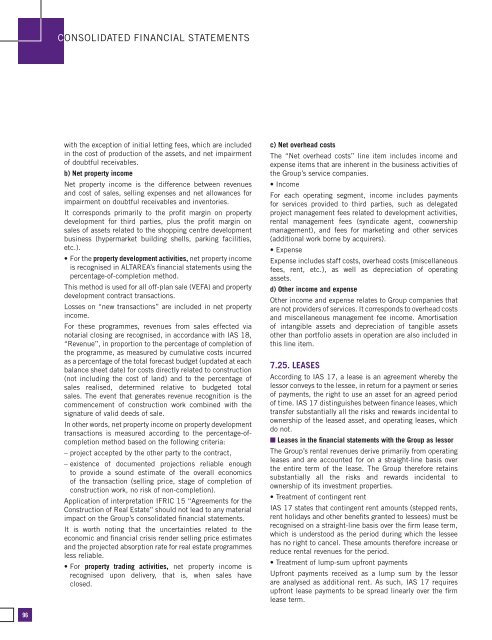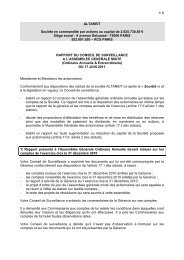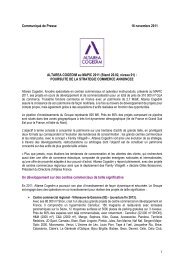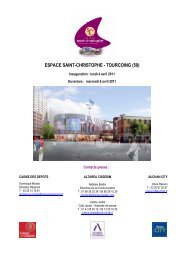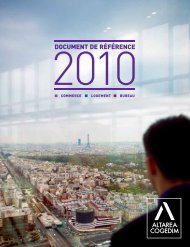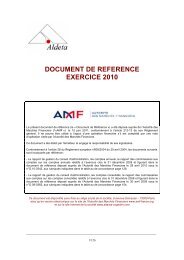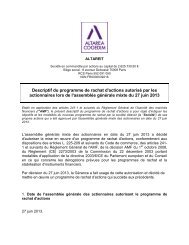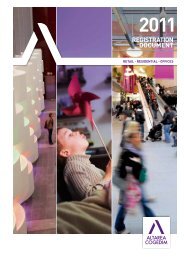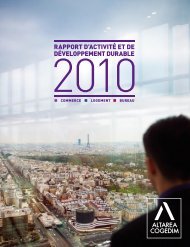Annual report 2008 - Altarea Cogedim
Annual report 2008 - Altarea Cogedim
Annual report 2008 - Altarea Cogedim
Create successful ePaper yourself
Turn your PDF publications into a flip-book with our unique Google optimized e-Paper software.
CONSOLIDATED FINANCIAL STATEMENTS<br />
with the exception of initial letting fees, which are included<br />
in the cost of production of the assets, and net impairment<br />
of doubtful receivables.<br />
b) Net property income<br />
Net property income is the difference between revenues<br />
and cost of sales, selling expenses and net allowances for<br />
impairment on doubtful receivables and inventories.<br />
It corresponds primarily to the profit margin on property<br />
development for third parties, plus the profit margin on<br />
sales of assets related to the shopping centre development<br />
business (hypermarket building shells, parking facilities,<br />
etc.).<br />
• For the property development activities, net property income<br />
is recognised in ALTAREA’s financial statements using the<br />
percentage-of-completion method.<br />
This method is used for all off-plan sale (VEFA) and property<br />
development contract transactions.<br />
Losses on “new transactions” are included in net property<br />
income.<br />
For these programmes, revenues from sales effected via<br />
notarial closing are recognised, in accordance with IAS 18,<br />
“Revenue”, in proportion to the percentage of completion of<br />
the programme, as measured by cumulative costs incurred<br />
as a percentage of the total forecast budget (updated at each<br />
balance sheet date) for costs directly related to construction<br />
(not including the cost of land) and to the percentage of<br />
sales realised, determined relative to budgeted total<br />
sales. The event that generates revenue recognition is the<br />
commencement of construction work combined with the<br />
signature of valid deeds of sale.<br />
In other words, net property income on property development<br />
transactions is measured according to the percentage-ofcompletion<br />
method based on the following criteria:<br />
– project accepted by the other party to the contract,<br />
– existence of documented projections reliable enough<br />
to provide a sound estimate of the overall economics<br />
of the transaction (selling price, stage of completion of<br />
construction work, no risk of non-completion).<br />
Application of interpretation IFRIC 15 “Agreements for the<br />
Construction of Real Estate” should not lead to any material<br />
impact on the Group’s consolidated financial statements.<br />
It is worth noting that the uncertainties related to the<br />
economic and financial crisis render selling price estimates<br />
and the projected absorption rate for real estate programmes<br />
less reliable.<br />
• For property trading activities, net property income is<br />
recognised upon delivery, that is, when sales have<br />
closed.<br />
c) Net overhead costs<br />
The “Net overhead costs” line item includes income and<br />
expense items that are inherent in the business activities of<br />
the Group’s service companies.<br />
• Income<br />
For each operating segment, income includes payments<br />
for services provided to third parties, such as delegated<br />
project management fees related to development activities,<br />
rental management fees (syndicate agent, coownership<br />
management), and fees for marketing and other services<br />
(additional work borne by acquirers).<br />
• Expense<br />
Expense includes staff costs, overhead costs (miscellaneous<br />
fees, rent, etc.), as well as depreciation of operating<br />
assets.<br />
d) Other income and expense<br />
Other income and expense relates to Group companies that<br />
are not providers of services. It corresponds to overhead costs<br />
and miscellaneous management fee income. Amortisation<br />
of intangible assets and depreciation of tangible assets<br />
other than portfolio assets in operation are also included in<br />
this line item.<br />
7.25. Leases<br />
According to IAS 17, a lease is an agreement whereby the<br />
lessor conveys to the lessee, in return for a payment or series<br />
of payments, the right to use an asset for an agreed period<br />
of time. IAS 17 distinguishes between finance leases, which<br />
transfer substantially all the risks and rewards incidental to<br />
ownership of the leased asset, and operating leases, which<br />
do not.<br />
n Leases in the financial statements with the Group as lessor<br />
The Group’s rental revenues derive primarily from operating<br />
leases and are accounted for on a straight-line basis over<br />
the entire term of the lease. The Group therefore retains<br />
substantially all the risks and rewards incidental to<br />
ownership of its investment properties.<br />
• Treatment of contingent rent<br />
IAS 17 states that contingent rent amounts (stepped rents,<br />
rent holidays and other benefits granted to lessees) must be<br />
recognised on a straight-line basis over the firm lease term,<br />
which is understood as the period during which the lessee<br />
has no right to cancel. These amounts therefore increase or<br />
reduce rental revenues for the period.<br />
• Treatment of lump-sum upfront payments<br />
Upfront payments received as a lump sum by the lessor<br />
are analysed as additional rent. As such, IAS 17 requires<br />
upfront lease payments to be spread linearly over the firm<br />
lease term.<br />
96


